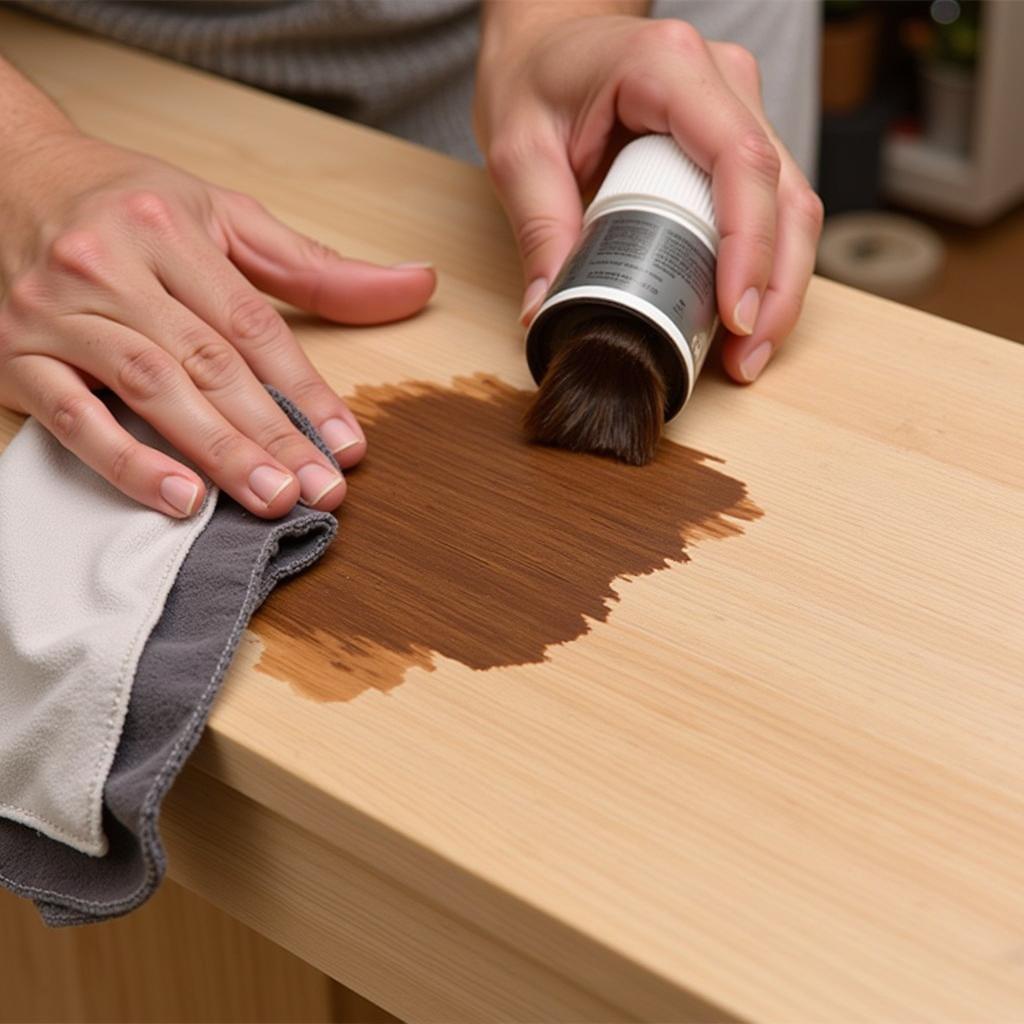Changing the color of stained wood can seem like a daunting task, but with the right knowledge and tools, it can be a satisfying DIY project. Whether you’re looking to revamp an old piece of furniture or simply want to update the look of your wood paneling, this guide will walk you through the process step-by-step.
Understanding Wood Stain and Its Removal
Before diving into the color changing process, it’s crucial to understand what wood stain is and how it differs from paint. Unlike paint, which sits on the surface, stain penetrates the wood fibers, enhancing its natural beauty and adding color.
This deep penetration, however, makes changing the color of stained wood a bit more complex than simply painting over it. You can’t just slap on a new coat of stain and expect it to adhere properly. The old stain needs to be either removed or significantly faded to achieve a desirable outcome.
Methods for Changing Stained Wood Color
There are several ways to change the color of stained wood, each with its pros and cons. The best method for you will depend on the type of wood, the existing stain, and the desired outcome.
1. Sanding: A Clean Slate
Sanding is the most effective way to completely remove the old stain and start fresh. This method involves using progressively finer grits of sandpaper to strip away the stain and create a smooth surface for the new color.
Pros:
- Provides a completely blank canvas
- Allows for a drastic color change
- Ensures even application of the new stain
Cons:
- Labor-intensive and time-consuming
- Can be dusty and messy
- Not suitable for intricate carvings
2. Chemical Strippers: Fast and Efficient
Chemical strippers offer a faster alternative to sanding, especially for larger surfaces or intricate pieces. These powerful solutions dissolve the existing stain, allowing you to scrape it away with ease.
Pros:
- Faster than sanding
- Effective for removing multiple layers of stain
- Suitable for intricate details
Cons:
- Can be harsh on the wood
- Requires proper ventilation and safety precautions
- May darken some wood types
3. Wood Bleach: Lightening the Tone
If you’re aiming for a lighter shade, wood bleach can be a valuable tool. It works by breaking down the color pigments in the existing stain, lightening the wood without removing its natural grain.
Pros:
- Effectively lightens wood tone
- Less abrasive than sanding
- Prepares the surface for a lighter stain
Cons:
- May not completely remove all stain colors
- Can be harsh on certain wood types
- Requires careful handling and neutralization
4. Applying a Darker Stain: The Layering Approach
Sometimes, you can change the color of stained wood by simply applying a darker stain over the existing one. This method works best when the current stain is light and the desired color is significantly darker.
Pros:
- Easiest and fastest method
- Doesn’t require stripping or sanding
- Enhances the wood grain
Cons:
- Limited color options (can only go darker)
- May not completely cover the old stain
- Requires careful selection of compatible stains
 Applying Darker Wood Stain over Existing Finish
Applying Darker Wood Stain over Existing Finish
Tips for Success
Regardless of the method you choose, here are some essential tips for successfully changing the color of stained wood:
- Test on a hidden area: Before applying any product to the entire surface, always test it on a small, inconspicuous area to ensure compatibility and desired results.
- Follow manufacturer instructions: Each product has specific instructions regarding application, drying time, and safety precautions. Always follow them carefully for optimal results.
- Work in a well-ventilated area: When using chemical strippers or wood bleach, ensure adequate ventilation to avoid inhaling harmful fumes.
- Protect yourself: Wear gloves, eye protection, and a mask when working with chemicals or sanding to protect your skin, eyes, and respiratory system.
- Be patient: Changing the color of stained wood takes time and effort. Don’t rush the process, and allow ample drying time between coats or steps.
Conclusion
Changing the color of stained wood might require some elbow grease and patience, but it’s a rewarding way to breathe new life into your furniture and décor. By understanding the different methods and following the expert tips outlined above, you can achieve stunning results and create a unique look that reflects your personal style. Remember to prioritize safety, take your time, and enjoy the process of transforming your wooden treasures.
FAQs
1. Can I paint over stained wood?
Yes, you can paint over stained wood, but proper preparation is crucial. You’ll need to clean the surface thoroughly, sand it lightly to create better adhesion, and apply a primer specifically designed for stained surfaces before painting.
2. How can I lighten stained wood without sanding?
If sanding isn’t an option, you can try using a wood bleach to lighten the stain. However, be aware that this method might not completely remove all the color and may not be suitable for all wood types.
3. Can I use gel stain over regular stain?
Yes, you can generally apply gel stain over regular stain, but it’s always best to test on a hidden area first. Gel stains are thicker and offer better coverage, making them a good option for covering existing stains.
4. How long should I wait to apply a new stain after stripping?
The drying time after stripping can vary depending on the type of stripper and the wood’s porosity. It’s essential to follow the manufacturer’s instructions and allow ample drying time, usually at least 24-48 hours, before applying a new stain.
5. What kind of finish should I use after changing the stain color?
Choosing the right finish is crucial for protecting your newly stained wood. Options include polyurethane, varnish, shellac, and oil-based finishes. Consider the desired sheen, durability, and level of protection when selecting a finish.
Need Help?
We understand that changing the color of stained wood can be a challenging task. If you need assistance or have any questions, don’t hesitate to contact our team of experts at 0373298888 or [email protected]. We’re here to help you every step of the way, from choosing the right products to achieving your desired results. Visit our store at 86 Cầu Giấy, Hà Nội, and let our friendly staff guide you towards creating your dream space.

